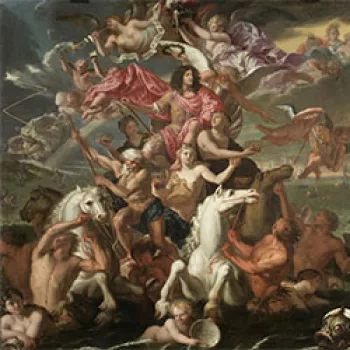The Infant Christ and Saint John Embracing c.1500-30
Oil on panel | 64.3 x 48.1 cm (support, canvas/panel/stretcher external) | RCIN 405463
-
The subject of this painting is the meeting and embrace of the infant Christ and Saint John the Baptist on Christ's return from Egypt. The naked infants are seated on the ground embracing; the slightly larger and more demonstrative child on the right is presumably the Baptist. Behind them is a cluster of rocks, with an extensive mountainous landscape on the right.
The painting belongs to a large group of works of approximately similar figural design, most of which are Netherlandish. The original composition is thought to be the invention of Leonardo da Vinci, although no paintings by him of the children alone can be traced. It may be that the idea was only ever expressed as a drawing. The motif can be found in a sheet of studies by Leonardo, of which there is a replica at Windsor; the group (in reverse) appears to have been drawn in the 1490s, presumably in Milan. The anatomical accuracy of the figures is impressive, and presupposes the dissection of children. It it was acquired as part of a purchase of 72 paintings from the Breda picture dealer William Frizell by Charles II in 1660, it was described as 'Christ & St. John of the painting of Leonardo da Vinci'. At 1,500 florins, this small work was the most expensive of the group of 72.
The dark colouring, simplified forms, fine botanical details and distinctive cloud-shapes seen here are typical of the work of Marco d'Oggiono and can also be found in his signed altarpiece The Three Archangels (Brera, Milan). Born near Lake Como c. 1475-7, he is probably the Marco recorded by Leonardo, 7 September 1490, living with him at Milan. The subject appears again in a painting by Bedoli in the Royal Collection (RCIN 401367).Provenance
Acquired by Charles II in 1660 for £150 from William Frizell at Breda (List II no 49) as Leonardo; recorded in the King's Closet at Whitehall in 1666 (no 335), where it is described as part of the 'Dutch present'
-
Creator(s)
-
Medium and techniques
Oil on panel
Measurements
64.3 x 48.1 cm (support, canvas/panel/stretcher external)
79.6 x 63.0 x 5.5 cm (frame, external, without buildup)
79.2 x 63.0 x 8.3 cm (frame, external, + buildup)
Category
Object type(s)









